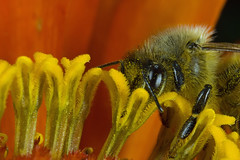If you’ve read my other posts on shooting insects (Shooting Butterflies and Shooting Dragonflies) then you can photograph the majority of the critters out there. But there are a few more useful tips that I can give you for shooting bees that are different than photographing other creatures so I’m listing them here.
Bees feed in a predictable pattern, both in the area that they are in and on the flowers that they get nectar from. If you see a bee feeding on a flower and it takes off odds are it will be back later (or one just like it). Honey bees communicate the location of the food sources that they discover, so if there is a flower that they like they’ll tell the hive where to find it. Bees feed on different flowers in different ways; Some flowers are shallow and it’s easy for the bee to feed from it –maybe they’ll only stay a second or two. Other flowers require the bee to go deep to get the nectar out, so they’ll stay in the flower longer –and you’ll have a better chance of getting the image you want…
Another thing to watch for is that bees move around a flower in a predictable way. I often frame the image and simply wait for the critter to get into the picture. The photo I’ve included with this post is a prime example –all I had to do is wait for the bee to move into the area I wanted it in and then press the shutter release. It was hot that day, the bees were very active, and yet I got a clear shot at twice life size. Easy, once you know what to look for…
A lot of insects, bees included, will occasionally stop to clean themselves. So if you see a bee that's actively feeding, but moving too fast to photograph, watch it for a while and see if it stops to clean the nectar from it's legs or antenna.
All insects get a little lethargic when the temperature rapidly drops, and bees seem to have a habit of getting caught out in the open when spring or fall storms roll in. Before, or after, it rains look for bees that have been slowed down by the changing weather so you can photograph them when they are barely moving.
If you are getting frustrated by fast moving bees put a little corn syrup in an area where they are feeding and photograph them while they eat. One word of warning: Use a little bit of corn syrup –putting a lot of it down won’t attract bees any faster than using a little, but you might empty an entire bee hive if you use a lot of it at once…
If the bees are actively feeding on a particular type of flower then simply use a syringe to inject some corn syrup into it. Once the ladies find it and start feeding they'll usually let you get close for a few photos.
On hot days put out a little water in a shallow dark colored saucer and photograph bees that stop for a drink.
Some bees are very aggressive and if they start acting threatening then leave them alone. I’ve had some honeybees bees go from casually feeding to being in my face faster than you can snap your fingers, and I’ve been chased out of an area on more than one occasion. They key to not getting stung is to not push them –if the bee wants you to leave then leave…
Last, but not least, never swat a bee that lands on you. Most of the time it's just stopping to take a breather and the bee has no intention of stinging you. I’ve had them land in my hair and all I had to do was shake my head to get it to leave. If you take a swing at one and miss odds are it will come back at you, and this time you will get stung. Honey bees not only communicate the location of food sources, but they can also tell the hive where to find that irritating photographer…


2 comments:
"If you are getting frustrated by fast moving bees put a little honey in an area where they are feeding and photograph them while they eat. One word of warning: Use a little bit of honey –putting a lot of it down won’t attract bees any faster than using a little, but you might empty an entire bee hive if you use a lot of it at once…"
Most imported honey contains foul brood spores, either European or American (EFB/AFB). Feeding honey to bees is a sure way of spreading this desease which is notifiable and usually results in colonies being destroyed.
NEVER FEED HONEY TO BEES UNLESS IT'S THEIR OWN
I've also heard, from bee keepers, that the quantities that I use when baiting bees is insignificant. But since I wrote that piece I've switched to using cornsyrup since it works just as well. So I'll edit the text soon to take out the honey.
Post a Comment